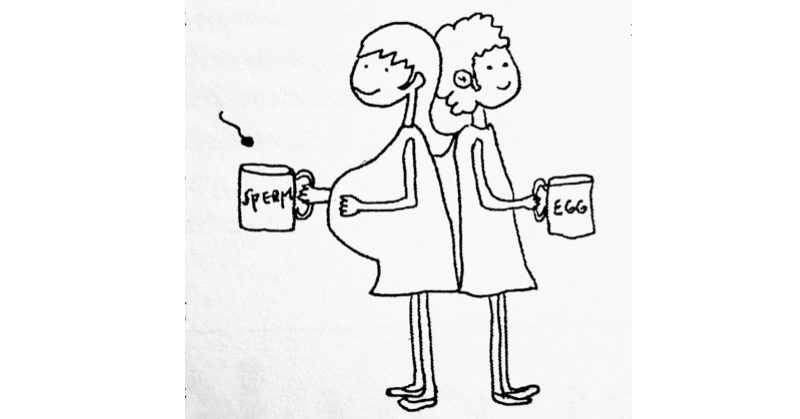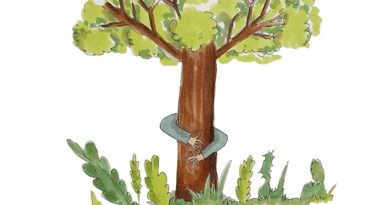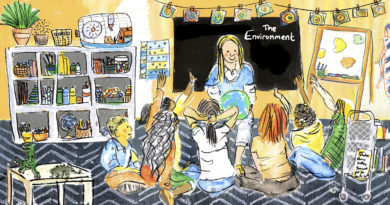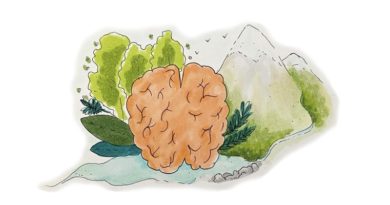Running the Baby Marathon
There weren’t too many days over the past 10 years when I didn’t consider a future without a baby. It was a fearful thought. The news of the arrival of a friend’s new baby was always accompanied by conflicting feelings of happiness and a guilty self-pitying ache.
We spent years trying for a baby before I finally saw a gynaecologist. I can’t recall how many in vitro fertilisation (IVF) cycles we went through; I lost count after 16. When I first started we had a biochemical pregnancy (a very early miscarriage). This convinced me that we could conceive and must be able to succeed. Then there was the pregnancy that continued beyond the week-two blood test. I was overjoyed when my body had finally managed to do what I so desperately wanted it to. The day before my six-week scan, the blood flowed; miserable, I went to my gynaecologist and informed her that I was sure I had miscarried. The scan was conclusive, no heartbeat. Adding injury to the pain of our loss, the miscarriage was incomplete and I had to wait to see if it resolved itself or if I needed to have a dilation and curettage (D&C).
Trying to rest and recover over summer at a beach house, I found that I was becoming increasingly unwell. The first trimester nausea continued, and three weeks later I lay in bed dry retching into a bucket feeling very sorry for myself. A fortnight later back in Melbourne at my first scan for the next IVF cycle, it was discovered that my uterus contained a growth. My ordinarily calm gynaecologist was alarmed and proceeded to arm against all eventualities, the worst being a molar pregnancy; an abnormal growth of the placenta, which, if left untreated, could spread through the body like a cancerous growth. The likely prognosis was that a small piece of placenta had attached to the top corner of my uterus. It was too dangerous to attempt a surgical removal. I left the gynaecologist’s with referrals for ongoing blood tests, treatment with Methotrexate (a chemotherapy drug), a referral for a chest x-ray, and advice to rest and take an extended period off work. My gynaecologist’s parting advice was “don’t Google ‘molar pregnancy’” and “we won’t be doing any more cycles until the Methotrexate has left your body.” That meant a six-month delay, and this occurred the year I turned 40.
The treatment did the job and killed off the growth. I had been despondent about my chances of becoming pregnant for a long time, and at each appointment asked my gynaecologist what my statistical chances really looked like at my age. Always the realist, I knew they dwindled; but as an optimist, I kept trying. After all, I had been pregnant, so pregnancy was still within the realm of possibility. The next cycle wasn’t good – poor-quality eggs and a lower-than-usual number. Turning 40 spurred me on: I had to maximise what fertility remained.
Scared that a pregnancy might never occur, we also had been investigating other options. We went to information sessions on adoption and learnt that it could take years if you were selected. Also the process was stressful, and we would have to conclude fertility treatment a year before we applied. There was no guarantee of success, given the small number of local children requiring adoption and the limitations, such as country of origin, religious affiliation, marital status, age, etc.
Each unsuccessful cycle took me further into despair. There seemed to be no escape. We had discussed egg donation and commenced advertising for a donor, but I harboured reservations. I never felt I would have difficulty bonding with a donor baby, but I was concerned that as a non-genetic mother I would be the odd one out. I foresaw a scene of my partner’s parents admiring our new baby and noting who the baby resembled. I would be the outsider – someone unrelated who would leave the room to make tea.
The strain was immense. I knew that my partner was over it, but he knew I wasn’t ready to give up, so he remained supportive. To break the deadlock, we decided to travel. I had come almost as far as I could but wanted to try natural cycles (without drugs). We had been advertising for a donor with no response, but made sure that an ad was placed while we were away.
The break did us good, but the question of “the baby” never left us. I wanted to do further natural cycles; however, I had moved forward and was open to having a “donor” baby, but donors were not forthcoming. I had been seeing an enormously supportive IVF counsellor and we had discussed the issue of egg donation over the years. She knew that people who wanted donors found them, often through relatives or friends, but sometimes through advertising.
After two years of advertising we were disheartened, as we had only had a couple of contacts, and they were women seeking financial remuneration or glory, not the altruistic donor we were after. Seeking money for egg donation is illegal in Australia and not consistent with our values. We had redrafted our advertisement a couple of times but decided that we needed to again. I poured my heart into that next ad and added a hotmail address alongside the post box we had been using over the years.
Then an amazing thing happened. I received a call at work from my counsellor who had been contacted by a woman who wanted to donate. The counsellor suggested me. I had to face the wall so that no one could see me cry. A baby seemed possible. The donor, Lucinda, wanted to help, because she had needed to create embryos for herself prior to treatment for Hodgkin’s Lymphoma. After recovery she become pregnant, so had never used them. Lucinda was offering eggs and embryos. I couldn’t believe this amazing offer had just dropped in my lap.
Meeting Lucinda and her family felt awkward, but was also reassuring. Considered, measured, and sensible, she saw donation from a pragmatic and scientific perspective, like donating any human tissue such as a kidney or blood. Seeing her two beautiful children, it was hard not to imagine what ours might look like. I wanted to try a cycle with a donated egg, rather than go straight to using the embryos. If we could have a child with a genetic link to one of us, we wanted to.
Lucinda generously helped us with two cycles, but no pregnancy resulted. We were very sad and had to take stock.
I was now 44. We had been doing everything humanly possible to have a family for nearly 10 years, and it had diminished our quality of life. Then I remembered the last ad we had run. I checked the hotmail account and I was overwhelmed to see responses. I screamed out to my partner to come and look as I started to read emails from beautiful women who cared and wanted to help.
The timing was perfect. Unbelievably, we received over a dozen offers. I thanked those that didn’t meet our basic criteria of being under 37 or having completed their own families, explaining why. Included amongst these was a woman who offered to donate as soon as she completed breastfeeding. I thanked her and urged her not to stop, as I had many offers. I emailed the others an overview of IVF, the legalities, and information about us. Our view was that any child resulting from a donation would know how they were conceived and have access to the donor. In the end I was communicating with two women and arranged to meet them. They were both lovely, and I couldn’t choose. We discussed the issues and arranged counselling and medical appointments. One couldn’t commit; but the other, Dianne, followed through and everything was ready for her to start in the New Year.
We were on holidays in New Zealand in January when I received an email from Dianne saying that, due to a change in family circumstances, she would not be able to be our donor. We were shattered. I wondered if it was something about me that made her change her mind, but concluded that she was either pregnant or her marriage had folded. I hoped it was the former and thanked her for coming as far as she had, as she had given me enough hope to keep trying.
We had lost six months and felt we were getting old. There seemed to be nothing left to do. We had ticked all the boxes trying everything to have a child. I sat down with the emails, now six months old, to make sure no stone was left unturned. I reread the email from the breastfeeding woman and realised that she had unnerved me by what she had said about donating: “I have always wanted to donate my eggs and have just gone on a list to be an anonymous donor….” Reading it afresh, I thought she didn’t sound odd, but rather like someone who really wanted to help.
When I emailed her, she was still keen to donate – very keen; this was something she had really always said that she would do. At age 21, Lily had been told that she would never have children. Fortunately, she defied medical advice and science and became pregnant in her early thirties. Despite being advised to terminate due to the risk to herself, she continued and at the time of contacting me was nursing her second gorgeous daughter. Lily wanted to help someone in a way that her sister and friends had said they would when she first received her devastating news.
Lily understood the imperative to get on with the job, as well as our desire for an open donation. We knew immediately that we could imagine keeping in touch with her, so that our child could know its origins.
Two embryos were created; the first implanted kept growing. I was pregnant, but it took months to believe. I loved being pregnant, although I was ill most days. At the end of my pregnancy, Melbourne had its worst heat wave and bushfires, but I didn’t mind that the baby was late and induced at 42 weeks. My obstetrician was impressed by my patience, but after everything, I was just happy to be pregnant.
Now I am a mother and have the most adorable son. I love being a mum and would go through all the pain of getting here again if I had to. Lily, the donor, came with her family to our son’s first birthday, and I took photos of him with her daughters. A month ago, I emailed Dianne (who at one stage was our last chance for a donor pregnancy) and told her that we had a baby. I am so glad I did. She was overjoyed at our news. It turns out she withdrew her offer because she was pregnant with a baby boy, whom she often looked at and felt guilty, thinking he should have been mine. But I know that my boy was always meant to be ours.
This story originally appeared in the print version of Mothering Matters in July 2010. It has been reused with permission.
The names used in this story, including that of the author, are pseudonyms.
By Louise Rosso
At the time of writing, Louise was 46 and working in industrial relations. She lives in Melbourne, Australia with her partner, two cats and now her son. Camping holidays, travelling, food, and friends are the things that make her tick.
Illustration by Ivy Hieber-Kwok
Ivy illustrated for Mothering Matters even “way back” in the print days.




